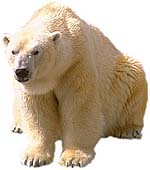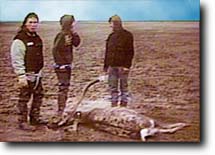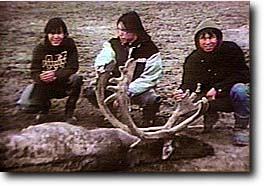
One last adventure

Jimmy (only 19 years old) agreed to take us ten miles down river to the Arctic Ocean. It was a nineteen foot fiberglass boat shell with a seventy-five horsepower outboard on the back. Buddy, George, Mike, and I paid him $50 for the ride. Dan decided not to go—he stayed behind to work on a dentistry article. Personally, I think he had experienced enough adventure for a while.
On the way down the Colville, the river split into many channels and became fairly shallow as we approached the ocean. The Eskimos said 40,000 caribou had gathered close to the ocean for the short summer.
We saw two small herds of 400 to 1,000 animals. The caribou were about ready to migrate south, over the Brooks range, for the winter. One of the herds we saw was on a plant-less island in the river. All the animals stay together in a single herd—the bulls, cows, and calves. It was neat to see so many of these wild animals together in one place.
I wondered why they were in a place with no plants. Maybe it was to get away from the bugs. I was told each animal can lose up to a quart of blood a week from the mosquitoes. That’s a lot of mosquito bites!

After a half hour boat ride, we were able to see the open ocean ahead of us. Along the horizon, the white ice cap could be seen. Jimmy took us out about twelve miles so we could get a good view of it. He didn’t want to get too close because the chunks of ice in the ocean became more numerous as we approached the cap. The water was cold, but was not as salty as other ocean water I have tasted.
Probably because of the large volume of fresh water being introduced by the Colville River. The ocean was not as choppy as I had expected. The water was rougher on the Colville River two days ago! We saw no wild life while out in the ocean. The polar bears usually summer out on the ice cap and then come inland for the winter. They are rarely seen.

Stuck!
On our way back, Jimmy tried to find the same delta channel we had left one hour before. The tide had gone out, and we had trouble getting back into the main channel. Suddenly, Jimmy shut the engine down. The prop was churning up the mud and the water was only two feet deep.
The first thing the four of us did was to look at our watches. We were grounded a mile out in the Arctic Ocean on the Colville River Delta and we had a plane to catch in four hours. We all jumped out and began to push the boat. We had to try to find deeper water.
This wasn’t anything new to us, we had done this drill many times in the week before. But who would have guessed we’d be wading around a mile out in the Arctic Ocean! Much to our relief, we were free in about fifteen minutes. How much more adventure could we take? Thanks Lord, for providing for us again.

Caribou Hunt
We saw a large caribou herd on our way back up the river to Nuiqsut. Jimmy had met two of his cousins in another boat and they decided to go into the herd and shoot a bull to take back with them. Hunting caribou is not anything like hunting deer in Ohio. Here, we have to be quiet and wait for the prey to come to us. The Eskimos walk nonchalantly into the middle of the panicking herd (I’m surprised they don’t get trampled) pick their bull, and shoot it.
We didn’t expect to be part of an Eskimo caribou hunt! They were successful and we helped them butcher a bull and carry the meat to the boat. An Eskimo custom is to take a bite out of the raw kidney of the animal.
Buddy and Mike decided to try it, George and I declined. I refused, because I know what the function of the kidney is and based on its function, what it probably would taste like. Buddy confirmed my expectations of taste after spitting out his small bite. He did hold it in his mouth long enough for a picture.

The Eskimos are allowed to kill up to five caribou a day. The caribou are only in their area for a short time, so they have to take advantage of them when they can. The Eskimos have several ice houses in which they store the meat. They dig holes deep into the permafrost where the meat keeps nicely. The other main staple of their diet is whale meat. Last year they killed three whales which fed their village for the year.

We thought we were done with all of our adventures, but on our way back to Nuiqsut, part of the herd was crossing the river. We were able to pull right up to some of the animals swimming in the water. There were dozens of them swimming all around us. We could reach out and touch them. What an experience! How great the Lord has been to us in allowing to experience everything we have. It has been one surprise after another.
We made it back to Nuiqsut by 2PM, expecting our pickup plane to arrive at 4PM. Just before 6PM we left Nuiqsut on our bush plane flight back to Fairbanks. But before leaving the North Slope, we talked the pilot into one last glimpse of the Arctic Ocean. The view of the delta, ocean, and the winding river on which we had struggled so much was unforgettable. We could see icebergs floating in the ocean.
The village of Nuiqsut looked like a postage stamp from the air. As we viewed the winding river below we had a flood of memories. Everything that we had gone through to collect a few dinosaur bones seemed unreal now. The bones must have something special in them. Tears came to our eyes as we were reminded of the awesome God we serve.
NEXT: The Great Alaskan Dinosaur Adventure HOMEPAGE
Copyright © 2000. All rights reserved.



